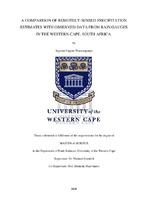| dc.contributor.advisor | Grenfell, Michael | |
| dc.contributor.author | Maswanganye, Sagwati Eugene | |
| dc.date.accessioned | 2018-08-06T12:22:51Z | |
| dc.date.available | 2018-08-31T22:10:06Z | |
| dc.date.issued | 2018 | |
| dc.identifier.uri | http://hdl.handle.net/11394/6199 | |
| dc.description | Magister Scientiae - MSc (Earth Science) | |
| dc.description.abstract | Precipitation data are critical for management of water resources. Precipitation can be
measured through ground measurement by means of rain gauges and by remote sensing
techniques. Rain gauges often give accurate measurements, however networks of rain gauges
are often sparse as they are costly and cannot be placed at all the desirable locations. The
alternative is remotely-sensed data which have large spatial coverage and high temporal
resolution. Remotely-sensed estimates need to generate realistic and reliable data in order to
be used in water resource assessments. Therefore there is need to evaluate the accuracy of
remote sensing techniques. This study investigated the reliability of the following satellite
derived rainfall estimates; Multi-Sensor Precipitation Estimator (MPE), Tropical
Applications of Meteorology using SATellite (TAMSAT) and Climate Hazards Group
InfraRed Precipitation with Stations (CHIRPS) in areas with contrasting topographical and
climatic characteristics in the Western Cape Province of South Africa. | |
| dc.language.iso | en | |
| dc.publisher | University of the Western Cape | |
| dc.title | A comparison of Remotely-Sensed Precipitation Estimates with observed data from rain Gauges in the Western Cape, South Africa | |
| dc.rights.holder | University of the Western Cape | |

